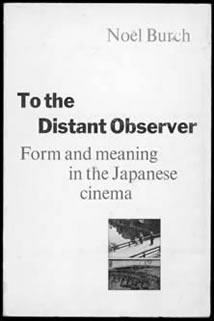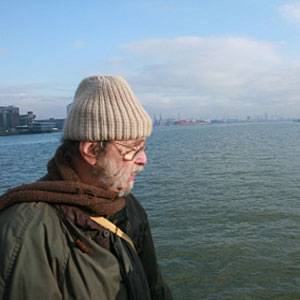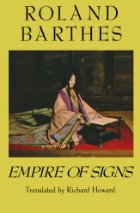From American Film (July-August 1979). Incidentally, Criterion’s recent Blu-Ray of Ugetsu is ravishing, regardless of what Burch says (or, rather, doesn’t say).– J.R.

To the Distant Observer: Form and Meaning in the Japanese Cinema by Noël Burch. Revised and edited by Annette Michelson. University of California Press, $19.50.

The most ambitious and detailed study of Japanese cinema since Joseph L. Anderson and Donald Richie’s pioneering history appeared twenty years ago, Noël Burch’s To the Distant Observer adopts an overall approach that is radically different from that of its predecessor. Modernist and materialist in orientation where other critics have been realist and transcendental, Burch argues for a nearly total revision of the way we perceive Japanese film — proposing a new set of criteria as well as an alternate canon of masterpieces.
To call his book controversial would almost be an understatement. Copies of a draft were circulated among a few film scholars in London more than four years ago, sparking a heated debate that has raged ever since. For Burch is arguing that “the most fruitful, original period” the Japanese film history coincided with the years between 1934 and 1943, when the Japanese people embraced “a national ideology akin to European fascism”. Burch claims that these years saw Ozu and Mizoguchi produce their finest work, while Naruse, Shimizu, Ishida, Yamanaka, and many others “helped to perfect an approach to filmmaking that was not only uniquely Japanese but was equal, at its best, to the finest achievements of the traditional arts of previous centuries.”
An American-born filmmaker, theorist, and teacher who has lived in France since 1951, Burch is also a Marxist whose political analysis of Japanese history is often quite distinct from his aesthetic positions. Yet to his credit, he shows none of the ideological innocence of those critics who claim that recent Hollywood films about Vietnam are “apolitical,” thereby ignoring or evading the political implications of their own responses. For better and for worse, he stands his ground and he grapples.
Having had an opportunity to see most of the Ozu and Mizoguchi films that Burch discusses at length, I would agree that many of them have been shamefully neglected in the United States in favor of the more conventional and “Western” works that succeeded them. Through their greater formal rigor and more extreme distancing effects, Ozu’s The Only Son (his first sound film, 1936; see first still below) and Mizoguchi’s Tale of Late Chrysanthemums (1939, see second still below) demand more from us than either Tokyo Story or Ugetsu Monogatari (both 1953) and yield more complex rewards.


As for Kurosawa, Burch characteristically shrugs off The Seven Samurai in a footnote. (Yojimbo, “one of the master’s most evident potboilers,” is said in another footnote to have launched the entire “spaghetti Western” genre.) He is much more attentive to Ikiru and Throne of Blood, Kurosawa’s powerful version of Macbeth .
Nagisa Oshima is also treated at some length, along with many films and filmmakers that earlier critics have virtually ignored, Conversely, some of the Japanese history that are best known in the West Mizoguchi’s Ugetsu and Yang Kwei Fei, Ozu’s Tokyo Story and An Autumn Afternoon, Shindo’s The Island — aren’t even mentioned.
One precaution that Burch has taken, however, is to clarify precisely which films he has seen. Another invaluable service of his book is to reproduce lists of the pre-1946 Japanese films that are available in Japanese archives today — even though this represents a pitifully small fraction of the industry’s output. Of the forty-one films made by Mizoguchi between 1922 and 1929, for instance, only a fragment of one is known to exist today.
Burch has many intriguing notions about what he calls the “presentational” aspects of Japanese art and how they relate to film history. Examining the standard rules of editing that are taken for granted in the West, he is fascinated by the steady refusal of a commercial, supposedly “realistic” director like Ozu to comply with all of them and by the complex implications of this refusal.
In the process of formulating his theory about Japanese cinema, Burch explores a lot of suggestive background material about what has made the development of this national cinema unique. The figure of the benshi — the live commentator who accompanied films with vocal explanations throughout the silent period — is central to this development. As audience attractions and “stars” in their own right, benshi exerted a marked influence over film production. By assuming the role of storyteller, for example, he implicitly allowed movies a greater independence from this function.
The fact that early Japanese films were shot at twelve frames per second, rather than the customary sixteen-to-twenty-frame average, suggests to Burch that Japanese spectators were less irritated by the flicker effect — and presumably less dependent on the illusion of a nonflickering continuity of images. And the Japanese film industry’s belated adoption of sound, in the mid-thirties, is treated as further evidence of a reluctance to conform with Western practices.
Burch also seems adept at interrelating films with other, more traditional aspects of Japanese culture. Parenthetical forays into architecture and the various spoken and written forms of Japanese are partcularly helpful. In an effort to link up certain formal traits of Mizoguchi and Ozu with traditional arts, some of Mizoguchi” s camera movements are labeled “scroll shots,” while Ozu’s celebrated cutaway still lifes are designated “pillow shots,” after the “pillow word” of classical Japanese poetry.
On the other hand, an ungainly portion of Burch’s book is devoted to overstating his case in a number of debatable and irritating ways. After discussing rensa-geki, a form of mixed-media performance that was popular in Japan between 1902 and 1922, and similar fusions of film and theater in France and Australia, he patly concludes that “all such Western experiments were extremely short-lived. Their discontinuous use of media was incompatible with the unity of the ‘illusionist’ system.”
But what about the discontinuous uses of film in, say, Orson Welles’s stage production of Around the World in 80 Days in 1946 or in Spike Jones’s live concerts in the fifties? Or to cite a current and reverse example, what about the uses of theatrical costumes, gestures, and lines by teenage spectators at midnight screenings of The Rocky Horror Picture Show?
A more general problem is Butch’s plodding academic style. Theoretically, perhaps, one can perceive his complex poetics of cinema through the medium of his dishrag prose; but such writers as Jean Cocteau or Sergei Eisenstein or Jean Epstein or Roland Barthes — all of whom know how to dance on a page — are much more persuasive and engaging about their own biases. Caught between two languages and not entirely at home with either, Burch has to worry about translating French concepts as well as Japanese concepts into English, and the ensuing crossfire is sometimes rather thick.

In striking contrast is Roland Barthes’s beautiful and untranslated book about Japan, L’Empire des signes (The Empire of Signs), whose radically imaginative approach to its subject has guided many of Burch’s insights — with mixed results. “If I wish to imagine a fictional people,” Barthes begins his book,
I can make a name for them, treat them declaratively, like an entity in a novel….I can also, without claiming to represent or analyze any reality whatsoever (such being the major endeavors of Western discourse), gather, somewhere in the world (out there), a number of features (in both the pictorial and linguistic sense), and with those features deliberately form a system. It is this system which I shall call Japan.
Without taking Barthes’ s poetic license quite so far, Burch nevertheless oscillates between an ideal, theoretical Japan and a material, historical one. He never quite balances the two. As a “distant observer,” he lacks the tools to attempt an ideological analysis of films he has many perceptive, formal insights about. Eschewing the graceful rhetoric of a Barthes, he can’t sweet-talk his way out of any of the contradictions he encounters — and he encounters quite a few.
Indeed, it’s often hard to agree with Burch about anything, even when he’s right, because of the peevish combativeness that often creeps into his tone. Yet the singular virtue of this provocative study is that one is continually learning something from it, even while one argues back. Burch’s Japan, however incomplete, is still another country — and one that is certainly worth knowing about.
